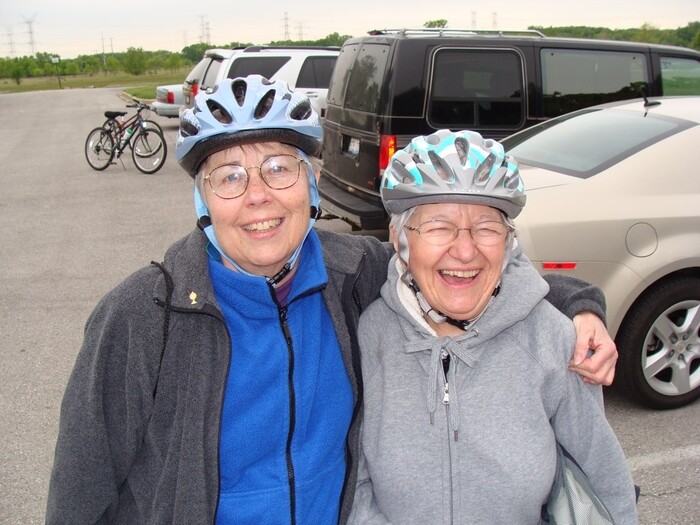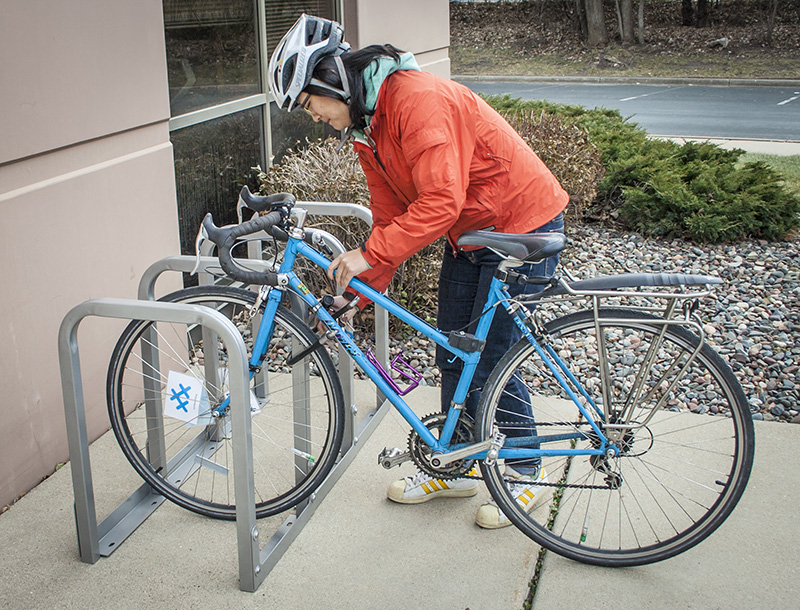
People bike for so many different reasons: for pleasure, for cost savings, for personal health, and for the health of the planet. You might be a parent biking with young children or someone who hasn’t ridden a bike in decades.
Whatever your reason for getting on a bike, we’re fortunate in the region to have some high-quality bike routes in Chicago and in many suburbs.
If you’re new to biking or someone who hasn’t been on a bike for a while, gathering a little knowledge beforehand will make getting around easier, safer, and more comfortable.
Here are some tips to make your biking experience more enjoyable.
MAKE YOUR RIDE EASIER
Choosing a route. Most people find that residential streets with little traffic are most comfortable for biking. Bike lanes often provide a welcoming atmosphere, too, even if they take you a bit out of the way.
Do the ABC Quick Check on your bike before every ride
Extend your cycling range with trains and buses. Front mounted bike racks on all local buses allow you to hop on the bus with your bike at any time. And thanks to multi-year efforts of Active Trans, you can also bring your bike on CTA and Metra trains, but there are restrictions on high traffic times. Metra has added dedicated bike cars on the Milwaukee District North Line, BNSF Line, and the Rock Island Line and Metra has also temporarily relaxed its bikes on trains policy and is allowing bikes on all trains across all 11 lines. Check with CTA and Metra for up-to-date info.

What to wear. Everyday clothing is fine for shorter rides. When temperatures are hot or your riding distance is longer, consider wearing synthetic wicking fabrics that dry more quickly.
On cooler days, a windbreaker is good to pack, especially if you’re riding near Lake Michigan. If you’re someone who gets cold easily, bring a backup layer with you. After some experimentation, you’ll discover what’s most comfortable for you.
Sunglasses and a hat with a visor (or a helmet with a visor) can help minimize the impact of the sun.
SAFETY
Stay visible at night. Even if there’s a slight chance you’ll be riding after dark, bring a red flashing light for the rear and white light in front. Don’t skip the front light: It will make you more visible to oncoming traffic. (Check out our video on why you need bike lights at night.)
Steer clear of the door zone. Hitting a car door that swings open in your path could be a very serious crash. If there isn’t enough room to ride 4 feet from parked cars and still provide passing motorists the minimum 3 feet of required safe passing distance, it might be safer to move to the center of the lane for a brief period to prevent unsafe passing.
Take extra care around large vehicles. Keep your distance and stay behind them when possible. They have blind spots and make wide turns.

Be predictable. Let motorists know what you’re doing by using hand signals (extending your arm to right or left) and checking behind you when turning and changing lanes.
Be courteous on the trail. Stay right while riding and pull off the trail when stopped. When passing someone walking or biking on the trail, give a clear signal with a bell or your voice.
Follow the law. You have the same rights and duties as drivers. That means obeying traffic signals and riding with traffic.
Protect your head. Think of a helmet the same way you think of a seat belt — a wise safety precaution. For proper fit:
- There should be about two fingers width between your eyebrows and the rim of the helmet.
- Adjust the side straps so that they form a “Y” with the junction directly below the earlobes.
- Tension should be adjusted on the strap under the chin so that you can feel the helmet pull down when the mouth is opened wide.
PRACTICAL MATTERS
Carrying stuff. Backpacks work well for many people, as do baskets and rear bike racks.
Invest in a U-lock. Keep your bike from getting stolen by using the most secure types of lock — a U-lock. They’re often used in concert with a heavy steel cable to ensure both wheels and the frame are secured. Don’t miss our two-part video on how to keep your bike secure.
MAKING IT FUN
Get social. For many people, biking serves as a social activity as much as it is a method of transportation, exercise, and reducing your carbon footprint. Biking provides a great way to meet new people and spend time with friends and family. One of the best ways to learn safe and effective biking is to go for rides with more experienced riders.
Explore your community. Riding a bike is a great way to get to know a place. Bikes lend themselves to exploration because it’s so easy to wander, easy to stop, and have a great view of everything while you’re doing it.
RESOURCES
- The Chainlink is a website catering to the local biking communities and offers a great place to learn about bike-related events and organized bike rides.
- The city of Chicago offers an up-to-date map on its website that will help you get around town efficiently.
- Don’t own a bike? Divvy, Chicago’s bikesharing service, offers both e-bikes and conventional bikes throughout the city.

- The Cook County Forest Preserve system maintains hundreds of miles of biking trails. DuPage County has loads of biking options, as well, including many miles of trails and suggested biking loops. McHenry, Lake, and Will County also have plenty of great biking options. Remove the hassle of driving to your suburban biking destination and take your bike on Metra
- Active Trans offers more safety tips and advice for bike commuters.
- If you ever experience a traffic crash while walking or bicycling in Chicagoland, be sure to use our Crash Support Helpline. Trained volunteers can help you take the right steps in the wake of a crash.
- Some tips if you’re thinking of buying a bike.
- Here’s a long list of resources related to biking and sustainable transportation in the region from Active Trans.
- BikeSafetyQuiz.com is a resource developed by Ride Illinois that teaches adults, children, and motorists how to share the road safely.
Please sign up for our e-newsletter if you want information about upcoming rides, news about biking improvements, and opportunities to get involved.
________________________________________________
Active Trans is able to carry out its work thanks to support and donations from people like you. If you’re not a member of Active Trans, please join us. Already a member? Consider donating to ensure that this important work keeps moving forward.
Two photos (bottom and second from top) are courtesy of Dero.

